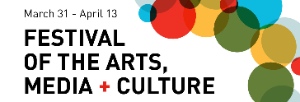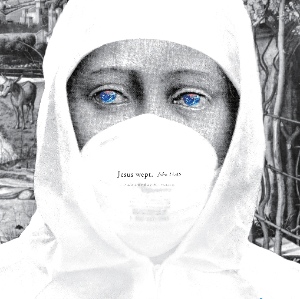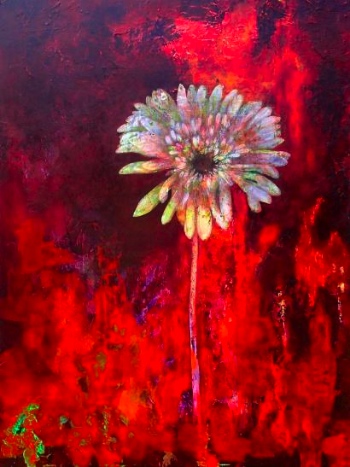Adam Back is a student in his last semester at Regent College, going out with a bang with a solo exhibition at the Lookout Gallery which runs until April 30. I sat down and chatted with him about enchiladas, flowers and the art of slowing down.
Charlene Kwiatkowski: What’s the significance of The Whole Enchilada? It seems a bit of an odd name for an art exhibit.
Adam Back: It is a bit of an odd name, and that’s pretty intentional. It’s a phrase I grew up hearing a lot in Texas. “Give me the whole enchilada,” which means you want it all – you want as much stuff crammed into that tortilla as possible.
My show is also the culmination of my time at Regent College, where I am doing a dual concentration in Biblical Studies and Christianity & the Arts . . . I have to write a theological reflection on art alongside a series of paintings I’m making. So calling the show and presentation “the whole enchilada” is my tongue-and-cheek way of summarizing everything that’s gone on for me at Regent in the last five years. . . .
CK: You mentioned growing up in Texas. Tell me a bit more of your background.
AB: Well, I grew up in Houston and moved to East Texas to do a BFA in Painting. After that, I did an MA in Painting at Stephen F. Austin University in Nacogdoches. Once I graduated, I moved to Colorado to work with kids coming out of youth corrections and got to live the dream every other weekend going fly fishing, backpacking or skiing. Then I ended up back in Texas a few years later and worked in construction management.
CK: So you weren’t doing art after graduating. Why now?
AB: I think a big part of it is my church and my pastor. I go to Immanuel Vancouver, a church that meets in the Rio Theatre on Commercial and Broadway. I was doing a pastoral internship at the time and one day, while hanging out with the pastor [Simon Neill] at Starbucks, he asked me, “So tell me about your art – why did you stop making it?”
I think it had been about six years since I put brush to canvas. I was so burned out after my MA and disillusioned with the rat race of the art world. And a lot of it too was space and time. Without space, it’s really hard to make art.
Simon said, “What if we make some of your internship hours studio hours?” He then said he could probably get me space at the church office where I could work.
I said, “That’s a great idea!” We also wanted to try running an arts community group at the church, so those two things coalesced and took off really well.
CK: So if it weren’t for Simon, would you be making art in Vancouver?
AB: Probably not. I think it was a wise and gracious push from Simon that opened up so much life for me. There were a lot of things going on for me at that time, and his nudging me back to the arts gave me a shock to the system that I needed to start integrating all the theology I was learning with my paintings, the arts group and my other relationships. It was really life-giving and still is.
CK: Why is it important that theology and art integrate?
AB: There’s a really long philosophical tradition as to why those things have been separated. Historically, in the West, a human being has been understood simply as a thinking thing – a receptacle for information. Scripturally, that’s not true.
There’s that great quote by Saint Irenaeus that says, “The glory of God is a human being fully alive.” What does it look like to be fully alive? That means our emotions, our physicality and, yes, our intellect, but I don’t think that means our intellect at the expense of loving to play frisbee in the park with your girlfriend, or cooking enchiladas or making a painting.
CK: Tell me more about how your faith informs your practice as an artist.
AB: Well the other big part of why I’m making art is because of my experience at Regent College. Regent has helped me see and understand where I fit into the story of what God is doing in the world.
I am challenged to ask, “What does a human life look like lived in the world before a God who’s creative, who spoke in parables, who came to us as the word made flesh? The story we get in the Bible is of a good God making a good universe – a good creation.
Within that universe, he places his images to steward and care for creation. We’ve done some really dark and evil things with that, but we’ve also done some really great things. I think God likes to be surprised in the sense of, “What are my images going to come up with?”
So when it comes to my own personal studio practices, this scriptural story opens up all kinds of possibilities because the stuff I make with is stuff that’s already been made. Most of my work is in mixed media/collage. For example, I’ll take trash found in the streets, old books, record albums, matchboxes, sheet music, and then I glue it all down, paint over top of it, scrape it all off, and glue it all back down again and draw on top of it. . . .
CK: So when people come to your exhibit, what do you want them to pay attention to or take away from it?
AB: . . . Hopefully when people come to the show, they see [the] care and attention to detail. The little collage surprises I put in my paintings – like matchbooks or traces of text – what does that communicate?
With our iPads, phones, and earbuds, we’re always connected. We can’t slow down and pay attention to one thing, and I think good art slows people down. The main thing I’d want to inspire in people would be for them to have at least one thing that they take time out for in their own lives.
And of course if they wanted to take away a painting with them, they’re welcome to do that too.
CK: At a cost, right?
AB: Haha, yes! Please!
CK: Looking at your website, I notice there are a lot of images with flowers. Is there a particular reason you’re drawn to flowers – pardon the pun?
AB: I’m sure there are lots of reasons. I’m always astounded with Vancouver in the spring when the tulips and peonies begin to bloom. People cultivate their gardens really well, and you have these firecrackers of colour all over the city. As I’m walking to the bus stop in the morning, I’ll miss the bus because I’m stopping to look at somebody’s flowers in their front yard, and I think, how boring life would be without flowers!
And by extension, how boring life would be without colour! Just think of all the various hues and tints of colours in just one petal of a rose. So yeah, I stop and smell the roses. At the same time, flowers are fragile things and only here for a while before they’re gone. There’s this ephemeral quality to their beauty, just as there is to life.
CK: So you’re essentially capturing something that’s impossible to capture.
AB: Exactly. There’s a beautiful tension between the material and the content.
CK: You mentioned earlier about leading an arts group at your church. What does that look like?
AB: At Immanuel, the demographic is extremely varied. We have folks from the Downtown Eastside and those that live in West Point Grey; people who work downtown in high-rises and homeless people who wander the streets; people in recovery from addictions and stay-at-home moms.
And so I look at pulling together this group of people around art as a way of mentoring and engaging our imaginations. It opens up new avenues to explore where God is in the midst of our lives and our blended community. How do we learn to see God and each other? It’s such a fascinating group because some people have art degrees and then others have never picked up a paintbrush before.
CK: What is the attraction for the person who’s never picked up a paintbrush before?
AB: We advertise the group – if that’s the word – as a group for artists, those interested in the arts, and just the generally curious. Creativity and imagination are so important for what it means to be human, and I think there’s a really strong dignity that plays out in the act of making things, particularly the act of making things together. And so I think folks are interested in exploring their faith from a different angle.
It ties in with what I said earlier about the Western conception of humans as just rational beings. We are far more than that, and art is a way of helping our faith take form and not just exist as propositions we agree with.
We meet twice a month to talk about art and then we do a project together that gets displayed at the front of the church for our whole community. I have some people who come just to be part of our discussions, and others who come just to do the art, and either or both is great.
The complete interview can be found at Charlene Kwiatkowski’s textingthecity blog. Charlene describes herself as “a city-lover living in Vancouver who would much rather view a bustling city street out my window than green fields filled with sheep or other pastoral creatures (although every landscape has its beauty). I write about the city I live in and the ones I occasionally visit.”
She works as publicist for the Surrey Art Gallery.
*****************************
There is quite a bit of art-related activity around Metro Vancouver at the moment. Here are some highlights:
 1. TWU: Festival of the Arts, Transpose
1. TWU: Festival of the Arts, Transpose
Trinity Western University’s Festival of the Arts, Media & Culture is running from March 30 – April 13. It features everything from jazz to drama and movies, but a major element is Transpose, the graduate art exhibition at Langley Centennial Museum, which runs until April 25.
2. L’Arche Vancouver: The Art Together Project
The Art Together Project will feature the collaborative work of people connected with L’Arche Vancouver. The event will take place April 24 at the Shadbolt Centre in Burnaby.
L’Arche Vancouver is part of an international movement founded by Jean Vanier; it describes itself this way:
L’Arche Greater Vancouver is a non-profit organization dedicated to creating homes and day programs in which people with and without developmental disabilities live, work and discover faith together. We live together as an intentional community.
New Westminster Christian Reformed Church will host the re:Create Art Show April 25 as a way of “celebrating the creational goodness of the arts and encouraging artists in our community.”
4. Deadline for Christian Seasons Calendar
Artists are invited to participate in the upcoming issue of Salt of the Earth: The Christian Seasons Calendar for 2015/2016. The deadline is April 20.
This unique calendar, produced by University Hill Congregation, follows the distinctive seasons of the Christian year and is distributed worldwide.
 5. Lookout Gallery: Fukushima to Vancouver
5. Lookout Gallery: Fukushima to Vancouver
And back at the Lookout Gallery – be sure to mark their next show on your calendar: Fukusima to Vancouver will feature “nine Japanese artists responding prayerfully to the 2011 Fukushima Triple Disaster – earthquake, tsunami, and nuclear crisis.” The show run from May 7 – June 25, with an opening reception on the first day.
Two other points related to the Lookout Gallery:
* It has a new website.
* Regent College has started a new Arts Internship Program:
Regent College will partner with a variety of arts organizations to offer internship experiences to students. Current partners include Pacific Theatre in Vancouver; the Grünewald Guild in Leavenworth, Washington; The Word Guild in Toronto; Pulp Literature Magazine in Vancouver; the Saint James Music Academy in Vancouver; and The Art Factory in Kandern, Germany. We plan to announce more partnerships soon. Participating students will gain experience in a chosen sector of the arts, enlarge their understanding of how an arts organization works in the public sphere, and grow in Christian discipleship and character.



